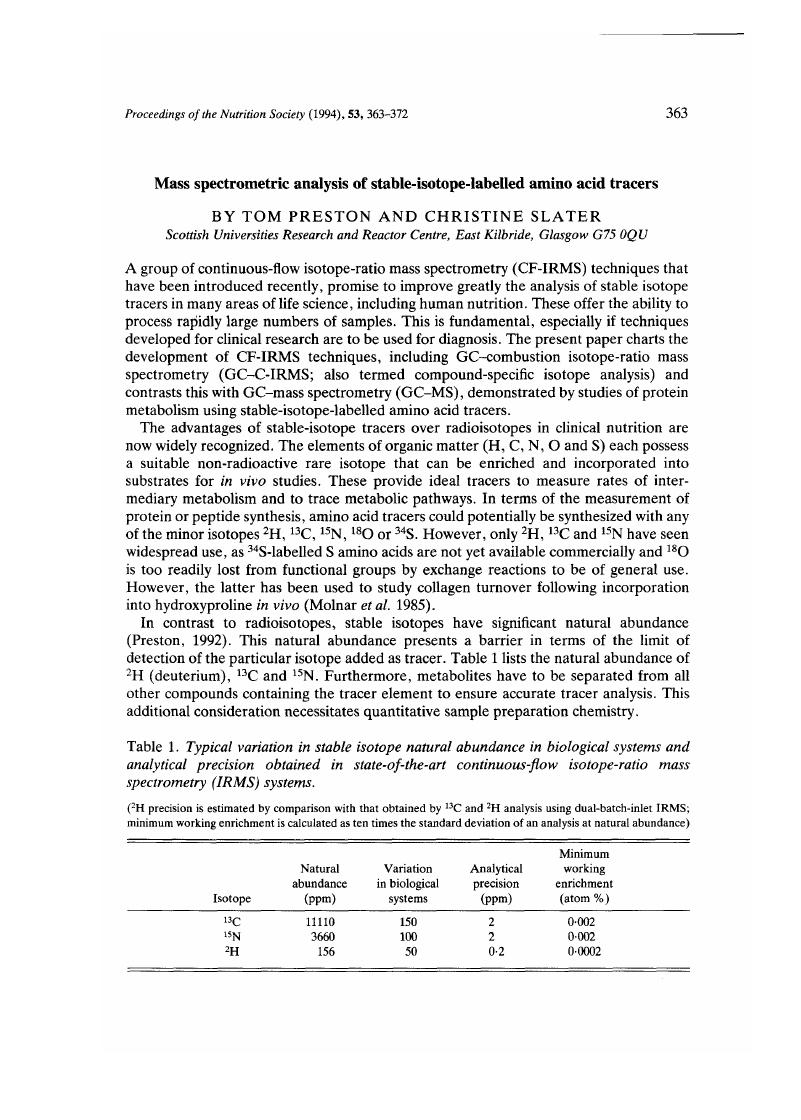Crossref Citations
This article has been cited by the following publications. This list is generated based on data provided by Crossref.
Slater, Christine
Preston, Tom
McMillan, Donald C.
Falconer, J. Stuart
and
Fearon, Kenneth C. H.
1995.
GC/MS analysis of [2H5]phenylalanine at very low enrichment: Measurement of protein synthesis in health and disease.
Journal of Mass Spectrometry,
Vol. 30,
Issue. 9,
p.
1325.
Tobias, Herbert J.
and
Brenna, J. Thomas
1996.
High-Precision D/H Measurement from Organic Mixtures by Gas Chromatography Continuous-Flow Isotope Ratio Mass Spectrometry Using a Palladium Filter.
Analytical Chemistry,
Vol. 68,
Issue. 17,
p.
3002.
Tobias, Herbert J.
and
Brenna, J. Thomas
1996.
Correction of Ion Source Nonlinearities over a Wide Signal Range in Continuous-Flow Isotope Ratio Mass Spectrometry of Water-Derived Hydrogen.
Analytical Chemistry,
Vol. 68,
Issue. 13,
p.
2281.
Brenna, J. Thomas
Corso, Thomas N.
Tobias, Herbert J.
and
Caimi, Richard J.
1997.
High-precision continuous-flow isotope ratio mass spectrometry.
Mass Spectrometry Reviews,
Vol. 16,
Issue. 5,
p.
227.
Macko, Stephen A.
Uhle, Maria E.
Engel, Michael H.
and
Andrusevich, Vladimir
1997.
Stable Nitrogen Isotope Analysis of Amino Acid Enantiomers by Gas Chromatography/Combustion/Isotope Ratio Mass Spectrometry.
Analytical Chemistry,
Vol. 69,
Issue. 5,
p.
926.
Burlingame, A. L.
Boyd, Robert K.
and
Gaskell, Simon J.
1998.
Mass Spectrometry.
Analytical Chemistry,
Vol. 70,
Issue. 16,
p.
647.
Goodman, Keith J.
1998.
Hardware Modifications to an Isotope Ratio Mass Spectrometer Continuous-Flow Interface Yielding Improved Signal, Resolution, and Maintenance.
Analytical Chemistry,
Vol. 70,
Issue. 5,
p.
833.
Garlick, Peter J.
and
McNurlan, Margaret A.
1998.
Measurement of protein synthesis in human tissues by the flooding method.
Current Opinion in Clinical Nutrition and Metabolic Care,
Vol. 1,
Issue. 5,
p.
455.
Meier-Augenstein, Wolfram
1999.
Use of gas chromatography-combustion-isotope ratio mass spectrometry in nutrition and metabolic research.
Current Opinion in Clinical Nutrition and Metabolic Care,
Vol. 2,
Issue. 6,
p.
465.
Meier-Augenstein, W.
1999.
Applied gas chromatography coupled to isotope ratio mass spectrometry.
Journal of Chromatography A,
Vol. 842,
Issue. 1-2,
p.
351.
Lichtfouse, Eric
2000.
Compound-specific isotope analysis. Application to archaelogy, biomedical sciences, biosynthesis, environment, extraterrestrial chemistry, food science, forensic science, humic substances, microbiology, organic geochemistry, soil science and sport.
Rapid Communications in Mass Spectrometry,
Vol. 14,
Issue. 15,
p.
1337.
Dänicke, S.
Böttcher, W.
Simon, O.
and
Jeroch, H.
2001.
The Measurement of Muscle Protein Synthesis in Broilers with a Flooding Dose Technique: Use of15N-Labelled Phenylalanine, GC-MS and GC-C-IRMS.
Isotopes in Environmental and Health Studies,
Vol. 37,
Issue. 3,
p.
213.
Ziadeh, Bassem I.
Michaud, Anthony L.
Saad, Nabil M. R.
Lewis, Betty A.
Rafii, Mahroukh
Pencharz, Paul B.
and
Brenna, J. Thomas
2002.
Enzymatic Decarboxylation of Tyrosine and Phenylalanine To Enhance Volatility for High-Precision Isotopic Analysis.
Analytical Chemistry,
Vol. 74,
Issue. 2,
p.
479.
Meier-Augenstein, Wolfram
2002.
Stable isotope analysis of fatty acids by gas chromatography–isotope ratio mass spectrometry.
Analytica Chimica Acta,
Vol. 465,
Issue. 1-2,
p.
63.
Bluck, L J C
and
Coward, W A
2004.
The application of a simple algorithm to isotope ratio measurements by gas chromatography/combustion/isotope ratio mass spectrometry.
Measurement Science and Technology,
Vol. 15,
Issue. 2,
p.
N21.
Morrison, Douglas J.
Cooper, Karen
Waldron, Susan
Slater, Christine
Weaver, Lawrence T.
and
Preston, Tom
2004.
A streamlined approach to the analysis of volatile fatty acids and its application to the measurement of whole‐body flux.
Rapid Communications in Mass Spectrometry,
Vol. 18,
Issue. 21,
p.
2593.
Bluck, Leslie J. C.
Clapperton, Allan T.
and
Coward, W. Andy
2005.
13C- and 2H-labelled glucose compared for minimal model estimates of glucose metabolism in man.
Clinical Science,
Vol. 109,
Issue. 6,
p.
513.
Meier-Augenstein, Wolfram
2006.
Forensic Human Identification.
p.
29.
Bell, J. Gordon
Preston, Tom
Henderson, R. James
Strachan, Fiona
Bron, James E.
Cooper, Karen
and
Morrison, Douglas J.
2007.
Discrimination of Wild and Cultured European Sea Bass (Dicentrarchus labrax) Using Chemical and Isotopic Analyses.
Journal of Agricultural and Food Chemistry,
Vol. 55,
Issue. 15,
p.
5934.
Morrison, Douglas J.
Preston, Tom
Bron, James E.
Hemderson, R. James
Cooper, Karen
Strachan, Fiona
and
Bell, J. Gordon
2007.
Authenticating Production Origin of Gilthead Sea Bream (Sparus aurata) by Chemical and Isotopic Fingerprinting.
Lipids,
Vol. 42,
Issue. 6,
p.
537.



